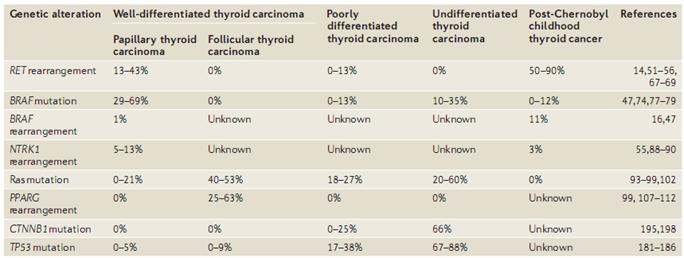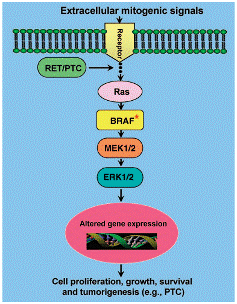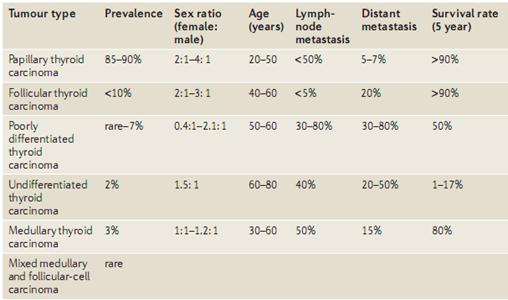


|
Statistical Prevalence |

|
Several critical parameters influencing the prognosis of thyroid cancer are that of† radiation exposure, age and gender.† Thyroid cancer is one of the common cancers that is exhibiting a global increase in incidence.† Reports have shown that exposure to low levels of radiation from such sources ac x-rays can increase the incidence of developing thyroid cancer.† By inducing chromosomal instability resulting in aberrant expressions of cellular proliferative genes as well as silencing of important tumor suppressor genes, radiation exposure can lead to an early onset of cellular differentiation and subsequently malignancy.† This is evident in Eastern Europe, where the Chernobyl nuclear incident have markedly increase the rate of thyroid cancer in both children and adults alike [3-5].† In addition, due to the higher incidence of thyroid cancer among women, it is hypothesized that the hormonal differences between gender plays an important role in the development of malignancy.† This can further be correlated to the fluctuations of steroids, such as estrogen, in women where the function of these compounds have direct effect on cellular proliferation [4-6]. |
|
Recent methods involving the detection of aberrant molecular pathways such as that of the MAPK pathway, Wnt pathway and that of tumor suppressor genes such as E2F have provided novel targets for both classifications of the cancer type as well as providing potential targets for pharmacological agents [3, 5, 7-11]. † Key extracellular signalling molecules modulating such important cellular behavior such as proliferation, contact inhibition, production of extracellular matrix degradation proteins such as matrix metalloproteinases, contact inhibition and even and apoptotic genes can be traced to the MAPK signaling pathway involving BRAF and RET effector molecules [3, 7, 12].† fluorescence analysis.† Application of fluorescent arrays on microfluidic chips may offer rapid detection of aberrant protein and chromosomal expressions within the cells.† Further, although rare for thyroid cancer, the detection of distant metastasis can be critical for the staging of the disease.† Circulating cancer cells within the blood can be sampled and fluorescently labeled for BRAF or RET which serve as signal amplification within the MAPK pathway, to determine the extent of metastasis. |

|
Prognosis of Thyroid Cancer |
|
Prevalence of Aberrant Genetic Mutations |

|
Table 1: Prognosis of† thyroid cancer and associated with age and gender biases [1]. |
|
Figure 3: Schematic of the MAPK signalling pathway prevalent in the majority of thyroid cancers [1]. Note, the lack of meaningful statistical data of this pathway is currently unavailable for ATC due to itsí rapid mortality rate.† In addition, ATC is categorized as undifferentiated thyroid cancer due to itsí preservation of molecular pathways required for proper cells function; this may be the cause of itís aggressiveness [3]. |
|
Aberrant expression of the MAPK pathway is often seen in many cancer due to itsí role in the regulation of cell cycle progression and cell proliferation.† BRAF and RET are key signalling molecules within the MAPK pathway and are commonly detected in differentiated thyroid cancer [3-5].† The abundant expression of these molecules in follicular and parafollicular C cells as a result of G-coupled protein signalling are potential indicators of their role in this molecular pathway as signal amplification.† Thus due to mutations within these loci, homeostasis is no longer preserved.† To show the significance of this pathway in the tumorigenesis process, it has be reported that up to 80% of thyroid cancer cases resulting from the Chernobyl accident exhibit expression of RET[13].† Further the expression of this pathway in the form of unregulated RET and BRAF have been linked to metastasis due to their role in secondary effects on such proteins as matrix metalloproteinase (MMPs) which are responsible for invasive mechanism of cancer cells [3, 13].† Although the expression of these signalling molecules is indication advanced tumor mutagenesis, it is also this genetic instability that has also limited the replicative potential of the cancer cells.† Relative to PTC, FTC and MTC, ATC is classified as undifferentiated cells, and it is this undifferentiated state in conjunction with minor mutations to key tumor suppressor genes which is the potential cause of† the aggressive nature of ATC.† By maintaining almost complete normal function of molecular function, ATC exhibits as rapid growth of the tumor, often doubling in size within on week [6-7]. |
|
Table 2: Prevalence of genetic mutations in thyroid cancer [1]. |